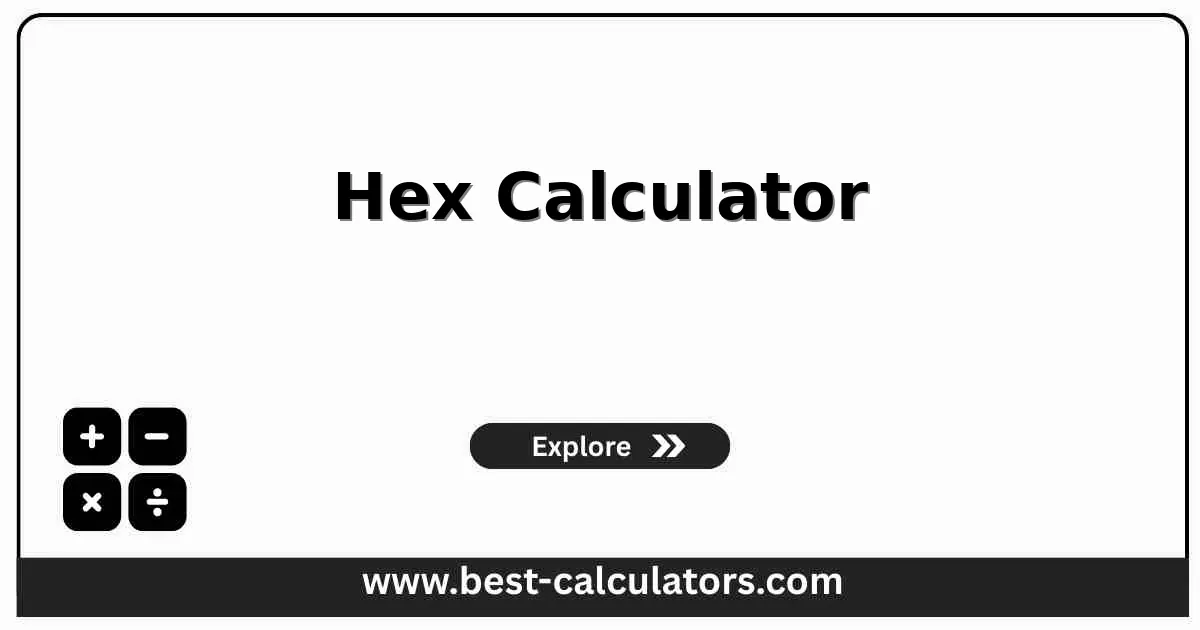Hex Calculator - Convert Hexadecimal to Decimal
Convert between hexadecimal, decimal, binary, and octal number systems with instant results.
Hex Calculator
Results
What is a Hex Calculator?
A Hex Calculator is a specialized tool that converts numbers between different number systems including hexadecimal (base-16), decimal (base-10), binary (base-2), and octal (base-8). It's essential for computer science, programming, and digital electronics work.
This calculator is particularly useful for:
- Programmers - Working with memory addresses, color codes, and low-level programming tasks.
- Computer Science Students - Learning number systems, data representation, and digital logic concepts.
- Web Developers - Converting hex color codes to RGB values and understanding web technologies.
- Electronics Engineers - Reading datasheets, debugging hardware, and working with microcontrollers.
For binary conversions specifically, try our binary converter for detailed binary operations.
If you need to work with different number bases and mathematical calculations, our percentage calculator handles various numeric operations.
How This Calculator Works
The calculator performs conversions using mathematical base conversion principles:
Each digit is multiplied by 16^position and summed
Example: 2F = (2×16¹) + (15×16⁰) = 47
Repeatedly divide by 16, collect remainders
Example: 47 ÷ 16 = 2 R15 → 2F
Each hex digit converts to 4 binary digits
Example: 2F = 0010 1111
The calculator automatically validates input based on the selected number system and displays all conversions simultaneously for easy comparison and verification.
Key Concepts Explained
Hexadecimal System
Base-16 number system using digits 0-9 and letters A-F. Widely used in computing because one hex digit represents exactly four binary bits.
Decimal System
Base-10 number system using digits 0-9. The standard number system used in everyday mathematics and human counting.
Binary System
Base-2 number system using only 0 and 1. The fundamental language of computers, representing on/off states in digital circuits.
Octal System
Base-8 number system using digits 0-7. Less common today but historically important in computing and still used in file permissions.
How to Use This Calculator
Select Input Type
Choose the number system of your input value: hexadecimal, decimal, binary, or octal.
Enter Value
Type your number in the selected format. Use 0-9 and A-F for hex, 0-1 for binary, 0-7 for octal, 0-9 for decimal.
Convert
Click 'Convert' to see the number represented in all four number systems simultaneously.
View Results
See hexadecimal, decimal, binary, and octal representations instantly for easy comparison and verification.
Benefits of Using This Calculator
- • Multi-Base Support: Convert between four different number systems (hex, decimal, binary, octal) in one convenient tool.
- • Instant Conversion: See all representations simultaneously without needing multiple conversion steps or calculators.
- • Input Validation: Automatic validation ensures you enter valid digits for each number system, preventing errors.
- • Programming Aid: Essential tool for debugging code, understanding memory addresses, and working with low-level programming.
- • Educational Value: Perfect for learning number systems and understanding how computers represent data internally.
- • Case Insensitive: Accepts both uppercase and lowercase hex letters (A-F or a-f) for user convenience.
Factors That Affect Your Results
- • Input Format: Each number system has specific valid characters. Hex uses 0-9 and A-F, binary only 0-1, octal 0-7, decimal 0-9.
- • Number Size: Very large numbers may have long binary representations. The calculator handles standard programming integer ranges.
- • Leading Zeros: Binary and octal often use leading zeros for alignment, while hex and decimal typically omit them.
- • Case Sensitivity: Hexadecimal letters can be uppercase or lowercase (A-F or a-f), and the calculator accepts both formats.
- • Negative Numbers: This calculator focuses on positive integers. For signed numbers, additional notation like two's complement is needed.

Frequently Asked Questions
What is hexadecimal and how does it work?
Hexadecimal is a base-16 number system using digits 0-9 and letters A-F. Each hexadecimal digit represents four binary digits (bits), making it compact for representing binary data. It's widely used in programming and computer science.
How do you convert hexadecimal to decimal?
To convert hex to decimal, multiply each digit by 16 raised to its position power (starting from 0 on the right) and sum the results. For example, 2F in hex = (2×16¹) + (15×16⁰) = 32 + 15 = 47 in decimal.
What letters are used in hexadecimal?
Hexadecimal uses letters A through F to represent decimal values 10 through 15. A=10, B=11, C=12, D=13, E=14, F=15. These letters can be uppercase or lowercase.
Why is hexadecimal used in programming?
Hexadecimal provides a compact way to represent binary data. One hex digit represents exactly four bits, making it easier to read and write than long binary strings. It's used for memory addresses, color codes, and debugging.
Can hexadecimal represent negative numbers?
Yes, hexadecimal can represent negative numbers using two's complement notation or by simply adding a minus sign. The representation method depends on the context and system being used.